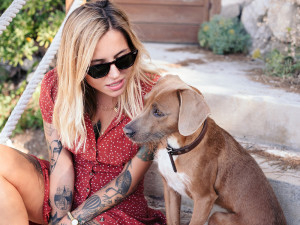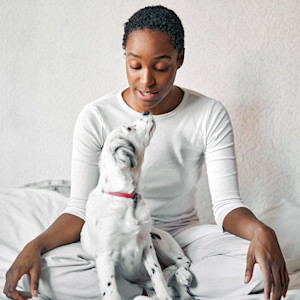The Psychology of Why We Make Up Voices for Our Pets
...And do our pets like it when we ventriloquize them?
As pet owners, we naturally want to communicate with our four-legged sidekicks. There’s talking to your pet; inferring what they want and saying it back to them, e.g., “you wanna go outside?”; and for some, a secret third thing: making up their voice and having them “speak” back.
Objectively, if anyone were to overhear me talking in a high-pitched, yet world-weary tone as a stand-in for my derpy pitt mix Bella, holding both sides of the conversation, they’d likely find it a bit eccentric. (For digital eavesdropping, see this detailed Reddit threadopens in a new tab of people’s dog voices.) But ventriloquizing your cat or dog is really just an example of our instinct for anthropomorphismopens in a new tab, with added dramatic flair.
Save on the litter with color-changing tech that helps you better care for your cat.
“It’s a way of entering into the animal’s perspective or experience, into their world,” explains Dr. Robert Mitchellopens in a new tab, Foundation Professor of Animal Studies and Psychology at Eastern Kentucky University. “By making what’s unverbalized, verbalized, [you’re] integrating with them.”
Beyond an attempt to flesh out your pet’s inner life, giving them a voice can also be a harmless way to entertain yourself, like you’re simultaneously writing and watching a talking dog feature. (After all, we grew up on cartoons and movies like “Homeward Bound”, maybe the fantasy imprinted on us.) Sometimes, it’s less about what you imagine they’re thinking, and more a vehicle to indirectly communicate with others through the pet proxy.
Do dogs and cats like when we ventriloquize them?
Your dog likely has no idea you’ve created a voice for them, much less a running script of nuanced opinions and sassy retorts, according to Dr. Stanley Corenopens in a new tab, Professor Emeritus in Psychology at the University of British Columbia, and author of “The Intelligence of Dogs”. But, they may take a heightened interest in how you sound when you’re speaking for them.
Coren explains that when we talk to dogs, we often use “motherese”opens in a new tab, a sing-songy, higher-pitched voice similar to the one we use with babies. (The dog version is sometimes called “doggerel”.) Science has shown that dogs actually prefer when we use this kind of pitch: A 2023 studyopens in a new tab used MRIs to show via brain scans that dogs were more receptive to both dog and infant-directed speech, especially when the voice was female. So even if you’re talking for your dog, “if we’re changing voices, then very often our dogs will pay more attention to us,” Coren says.
Hormones are also at play. When the change in vocal tone prompts your pup to tilt their head and make eye contact with you, that releases oxytocinopens in a new tab, the “love hormone”, which helps the two of you bond.
On the cat side, feline behavior and feeding coach Jennifer Van de Kieftopens in a new tab says cats like the attention. “I think cats like it when we talk to them, and even if you’re talking for them it’s still your voice,” she says. “You’re looking at them, focused on them, and it’s a positive, affectionate way to interact with them.”
But make sure you’re reading their body language to ensure they’re comfortable. If the cat stays near you; purrs or gently meows; has their tail high up in the air; or is lying down in a relaxed position, legs spread out or belly up, those are all signs of a happy cat. Conversely, if you see tucked paws or tail; ears back; hair spiked; or hear them hiss or see them physically retreating, those are signs of distress. Dog-wise, look for a wagging/neutral tail, relaxed ears, or loose shoulders; take heed of a stiff tail, tense body, excessive yawning, and bared teeth or growling.
Speaking to others through your pet
When Van de Kieft’s son Jake was growing up, she would sometimes talk with him through their cats. She’d make up funny voices to suit the different felines’ personalities, and verbalize their body language, e.g., “I want you to pet me right now.” It was a fun activity and a way for him to learn empathy—for the cats, and by extension, others, she says.
As Jake got a little older, the cats became a helpful sounding board. “Talking to an imaginary friend or stuffed animal can be easier for kids to talk about their day or their feelings, and I would respond as the cat,” she says. “Instead of telling your mom, he had this other outlet, where the cat was the good listener, providing the ear and the comfort.”
Linguistics professor and author Deborah Tannenopens in a new tab has studied how families use their pets as proxies. In her essayopens in a new tab “Talking the Dog: Framing Pets as Interactional Resources in Family Discourse,” Tannen writes that pets “become resources by which speakers buffer criticism, effect frame shifts, deliver praise, teach values, mediate or avoid conflict, and both reflect and constitute the participants’ family identities.” In one example, a couple is having a fight, when the man speaks in the chihuahua’s voice to say, “Mommy’s so mean tonight.” It diffuses the argument by making the woman laugh.
Sometimes, it’s just a way to have fun with your dog and each other. When Bella takes an especially long pee, my boyfriend lets out an exaggerated exhale, like she’s an old man relieving himself after several pints, and we both crack up. He says it’s a nod to an old Adam Sandler bitopens in a new tab. Does this make us feel closer to Bella, by vocalizing her urinary satisfaction? Maybe. But it’s for sure a way to amuse ourselves on a routine walk.
As Coren puts it, “If your dog can’t give you a laugh, then you probably shouldn’t be having a dog.”






